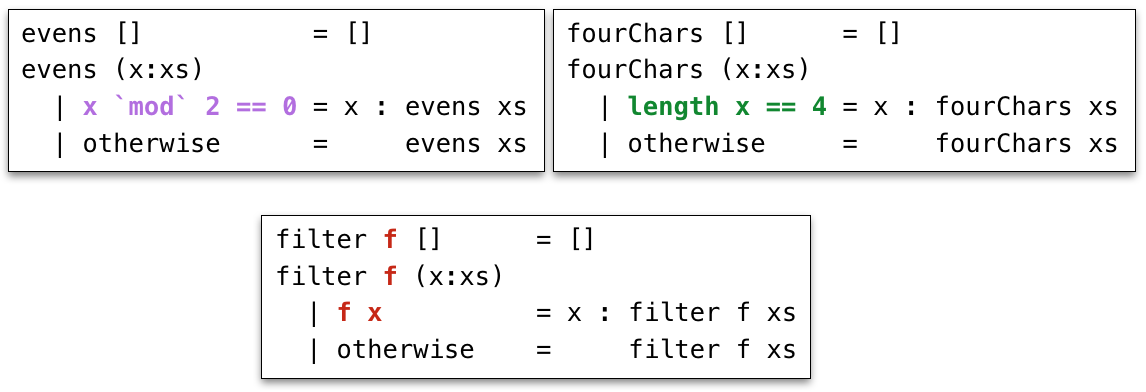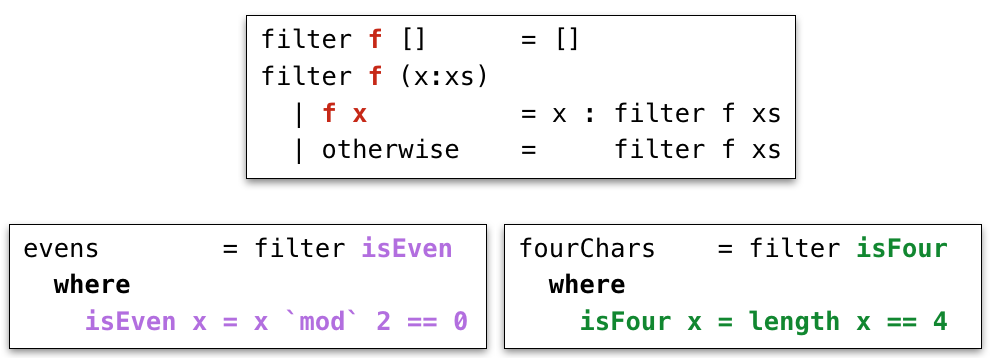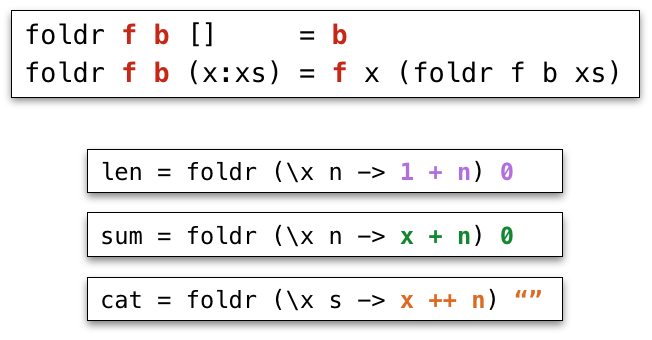Plan for this week
Last week:
- user-defined data types
- and how to manipulate them using pattern matching and recursion
- how to make recursive functions more efficient with tail recursion
This week:
code reuse with higher-order functions (HOFs)
some useful HOFs:
map,filter, andfold
Recursion is good…
Recursive code mirrors recursive data
- Base constructor -> Base case
- Inductive constructor -> Inductive case (with recursive call)
But it can get kinda repetitive!
Example: evens
Let’s write a function evens:
Example: four-letter words
Let’s write a function fourChars:
Yikes, Most Code is the Same
Lets rename the functions to foo:
foo [] = []
foo (x:xs)
| x mod 2 == 0 = x : foo xs
| otherwise = foo xs
foo [] = []
foo (x:xs)
| length x == 4 = x : foo xs
| otherwise = foo xsOnly difference is condition
x mod 2 == 0vslength x == 4
Moral of the day
D.R.Y. Don’t Repeat Yourself!
Can we
- reuse the general pattern and
- substitute in the custom condition?
HOFs to the rescue!
General Pattern
- expressed as a higher-order function
- takes customizable operations as arguments
Specific Operation
- passed in as an argument to the HOF
The “filter” pattern

filter PatternGeneral Pattern
- HOF
filter - Recursively traverse list and pick out elements that satisfy a predicate
Specific Operations
- Predicates
isEvenandisFour

filter instancesAvoid duplicating code!
Let’s talk about types
-- evens [1,2,3,4] ==> [2,4]
evens :: [Int] -> [Int]
evens xs = filter isEven xs
where
isEven :: Int -> Bool
isEven x = x `mod` 2 == 0
-- fourChars ["i","must","do","work"] ==> ["must","work"]
fourChars :: [String] -> [String]
fourChars xs = filter isFour xs
where
isFour :: String -> Bool
isFour x = length x == 4
So what’s the type of filter?
filter :: (Int -> Bool) -> [Int] -> [Int] -- ???
filter :: (String -> Bool) -> [String] -> [String] -- ???It does not care what the list elements are
- as long as the predicate can handle them
It’s type is polymorphic (generic) in the type of list elements
-- For any type `a`
-- if you give me a predicate on `a`s
-- and a list of `a`s,
-- I'll give you back a list of `a`s
filter :: (a -> Bool) -> [a] -> [a]
Example: all caps
Lets write a function shout:
Example: squares
Lets write a function squares:
Yikes, Most Code is the Same
Lets rename the functions to foo:
-- shout
foo [] = []
foo (x:xs) = toUpper x : foo xs
-- squares
foo [] = []
foo (x:xs) = (x * x) : foo xs
Lets refactor into the common pattern
The “map” pattern

map PatternGeneral Pattern
- HOF
map - Apply a transformation
fto each element of a list
Specific Operations
- Transformations
toUpperand\x -> x * x
Lets refactor shout and squares

map instances
QUIZ
What is the type of map?
(A) (Char -> Char) -> [Char] -> [Char]
(B) (Int -> Int) -> [Int] -> [Int]
(C) (a -> a) -> [a] -> [a]
(D) (a -> b) -> [a] -> [b]
(E) (a -> b) -> [c] -> [d]
-- For any types `a` and `b`
-- if you give me a transformation from `a` to `b`
-- and a list of `a`s,
-- I'll give you back a list of `b`s
map :: (a -> b) -> [a] -> [b]Type says it all!
The only meaningful thing a function of this type can do is apply its first argument to elements of the list
Hoogle it!
Things to try at home:
can you write a function
map' :: (a -> b) -> [a] -> [b]whose behavior is different frommap?can you write a function
map' :: (a -> b) -> [a] -> [b]such thatmap' f xsreturns a list whose elements are not inmap f xs?
QUIZ
What is the value of quiz?
(A) [2, 4, 6]
(B) [3, 5]
(C) Syntax Error
(D) Type Error
(E) None of the above
Don’t Repeat Yourself
Benefits of factoring code with HOFs:
Reuse iteration pattern
think in terms of standard patterns
less to write
easier to communicate
Avoid bugs due to repetition
Recall: length of a list
Recall: summing a list
Example: string concatenation
Let’s write a function cat:
-- cat [] ==> ""
-- cat ["carne","asada","torta"] ==> "carneasadatorta"
cat :: [String] -> String
cat [] = ...
cat (x:xs) = ...
Can you spot the pattern?
-- len
foo [] = 0
foo (x:xs) = 1 + foo xs
-- sum
foo [] = 0
foo (x:xs) = x + foo xs
-- cat
foo [] = ""
foo (x:xs) = x ++ foo xs
The “fold-right” pattern

foldr PatternGeneral Pattern
- Recurse on tail
- Combine result with the head using some binary operation
Let’s refactor sum, len and cat:
Factor the recursion out!

foldr instancesYou can write it more clearly as
The “fold-right” pattern
foldr f b [a1, a2, a3, a4]
==> f a1 (foldr f b [a2, a3, a4])
==> f a1 (f a2 (foldr f b [a3, a4]))
==> f a1 (f a2 (f a3 (foldr f b [a4])))
==> f a1 (f a2 (f a3 (f a4 (foldr f b []))))
==> f a1 (f a2 (f a3 (f a4 b)))Accumulate the values from the right
For example:
foldr (+) 0 [1, 2, 3, 4]
==> 1 + (foldr (+) 0 [2, 3, 4])
==> 1 + (2 + (foldr (+) 0 [3, 4]))
==> 1 + (2 + (3 + (foldr (+) 0 [4])))
==> 1 + (2 + (3 + (4 + (foldr (+) 0 []))))
==> 1 + (2 + (3 + (4 + 0)))
QUIZ
What does this evaluate to?
(A) Type error
(B) [1,2,3]
(C) [3,2,1]
(D) [[3],[2],[1]]
(E) [[1],[2],[3]]
foldr (:) [] [1,2,3]
==> (:) 1 (foldr (:) [] [2, 3])
==> (:) 1 ((:) 2 (foldr (:) [] [3]))
==> (:) 1 ((:) 2 ((:) 3 (foldr (:) [] [])))
==> (:) 1 ((:) 2 ((:) 3 []))
== 1 : (2 : (3 : []))
== [1,2,3]
QUIZ
What is the most general type of foldr?
(A) (a -> a -> a) -> a -> [a] -> a
(B) (a -> a -> b) -> a -> [a] -> b
(C) (a -> b -> a) -> b -> [a] -> b
(D) (a -> b -> b) -> b -> [a] -> b
(E) (b -> a -> b) -> b -> [a] -> b
Tail Recursion
Recursive call is the top-most sub-expression in the function body
i.e. no computations allowed on recursively returned value
i.e. value returned by the recursive call == value returned by function
QUIZ: Is this function tail recursive?
fac 10000 ==> 10000 * (fac 9999) ==> 10000 * 9999 * (fac 9998)
facTR 10000 ==> loop 1 10000 ==> loop 10000 (9999) ==> loop (10000 * 9999) (9998) ==> loop (10000 * 9999 * 9998) (9997)
A. Yes
B. No
Tail recursive factorial
Let’s write a tail-recursive factorial!
facTR :: Int -> Int
facTR n = loop 1 n
where
loop acc n
| 1 <= n = loop (acc * n) (n - 1)
| otherwise = acc
Lets see how facTR is evaluated:
facTR 4
==> loop 1 4 -- call loop 1 4
==> loop 4 3 -- rec call loop 4 3
==> loop 12 2 -- rec call loop 12 2
==> loop 24 1 -- rec call loop 24 1
==> 24 -- return result 24! Each recursive call directly returns the result
without further computation
no need to remember what to do next!
no need to store the “empty” stack frames!
Why care about Tail Recursion?
Because the compiler can transform it into a fast loop
function facTR(n){
var acc = 1;
while (true) {
if (n <= 1) { return acc ; }
else { acc = acc * n; n = n - 1; }
}
}Tail recursive calls can be optimized as a loop
- no stack frames needed!
Part of the language specification of most functional languages
- compiler guarantees to optimize tail calls
Tail Recursive Fold
Is foldr tail recursive?
What about tail-recursive versions?
Let’s write tail-recursive sum!
Lets run sumTR to see how it works
sumTR [1,2,3]
==> helper 0 [1,2,3]
==> helper 1 [2,3] -- 0 + 1 ==> 1
==> helper 3 [3] -- 1 + 2 ==> 3
==> helper 6 [] -- 3 + 3 ==> 6
==> 6Note: helper directly returns the result of recursive call!
Let’s write tail-recursive cat!
Lets run catTR to see how it works
catTR ["carne", "asada", "torta"]
==> helper "" ["carne", "asada", "torta"]
==> helper "carne" ["asada", "torta"]
==> helper "carneasada" ["torta"]
==> helper "carneasadatorta" []
==> "carneasadatorta"Note: helper directly returns the result of recursive call!
Can you spot the pattern?
-- sumTR
foo xs = helper 0 xs
where
helper acc [] = acc
helper acc (x:xs) = helper (acc + x) xs
-- catTR
foo xs = helper "" xs
where
helper acc [] = acc
helper acc (x:xs) = helper (acc ++ x) xs
The “fold-left” pattern

foldl PatternGeneral Pattern
- Use a helper function with an extra accumulator argument
- To compute new accumulator, combine current accumulator with the head using some binary operation
Let’s refactor sumTR and catTR:
Factor the tail-recursion out!
QUIZ
What does this evaluate to?
foldl f b xs = helper b xs
where
helper acc [] = acc
helper acc (x:xs) = helper (f acc x) xs
quiz = foldl (\xs x -> x : xs) [] [1,2,3](A) Type error
(B) [1,2,3]
(C) [3,2,1]
(D) [[3],[2],[1]]
(E) [[1],[2],[3]]
foldl f b (x1: x2: x3 : [])
==> helper b (x1: x2: x3 : [])
==> helper (f x1 b) (x2: x3 : [])
==> helper (f x2 (f x1 b)) (x3 : [])
==> helper (f x3 (f x2 (f x1 b))) []
==> ( x3 : (x2 : (x1 : [])))
The “fold-left” pattern
foldl f b [x1, x2, x3, x4]
==> helper b [x1, x2, x3, x4]
==> helper (f b x1) [x2, x3, x4]
==> helper (f (f b x1) x2) [x3, x4]
==> helper (f (f (f b x1) x2) x3) [x4]
==> helper (f (f (f (f b x1) x2) x3) x4) []
==> (f (f (f (f b x1) x2) x3) x4)Accumulate the values from the left
For example:
foldl (+) 0 [1, 2, 3, 4]
==> helper 0 [1, 2, 3, 4]
==> helper (0 + 1) [2, 3, 4]
==> helper ((0 + 1) + 2) [3, 4]
==> helper (((0 + 1) + 2) + 3) [4]
==> helper ((((0 + 1) + 2) + 3) + 4) []
==> ((((0 + 1) + 2) + 3) + 4)
Left vs. Right
foldl f b [x1, x2, x3] ==> f (f (f b x1) x2) x3 -- Left
foldr f b [x1, x2, x3] ==> f x1 (f x2 (f x3 b)) -- RightFor example:
foldl (+) 0 [1, 2, 3] ==> ((0 + 1) + 2) + 3 -- Left
foldr (+) 0 [1, 2, 3] ==> 1 + (2 + (3 + 0)) -- RightDifferent types!
Higher Order Functions
Iteration patterns over collections:
- Filter values in a collection given a predicate
- Map (iterate) a given transformation over a collection
- Fold (reduce) a collection into a value, given a binary operation to combine results
HOFs can be put into libraries to enable modularity
Data structure library implements
map,filter,foldfor its collectionsgeneric efficient implementation
generic optimizations:
map f (map g xs) --> map (f.g) xs
Data structure clients use HOFs with specific operations
- no need to know the implementation of the collection
Crucial foundation of
“big data” revolution e.g. MapReduce, Spark, TensorFlow
“web programming” revolution e.g. Jquery, Angular, React
